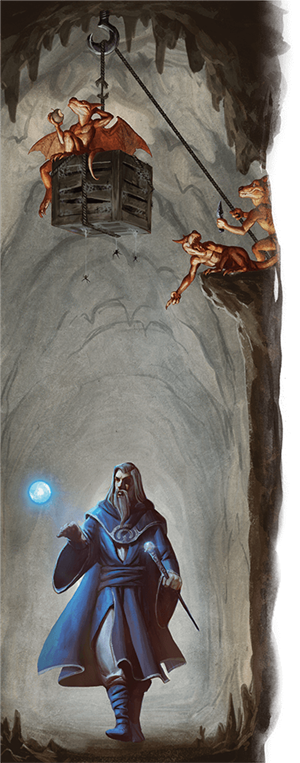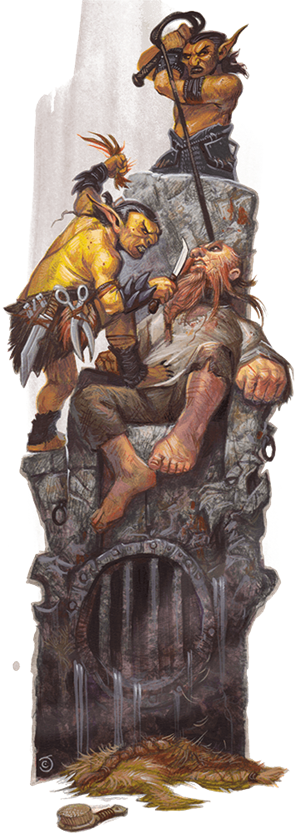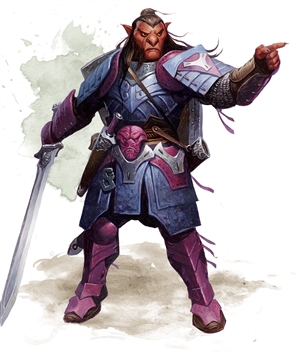“You can’t win. But there are alternatives to fighting.”
—Sir Alec Guinness as Obi-Wan Kenobi, Star Wars (1977)
 If every fight in your D&D campaign is a fight to the death, you’re making your game worse. There are dozens of reasons why. If the goal of every encounter is to rout the enemy, your game will become predictable and rote. If you force your players to chase down every fleeing goblin and squish every giant centipede before your encounter ends, your fight loses all tension and becomes a mindless grind. But just as there are multitudinous pitfalls in encounter design, the best Dungeon Masters know that there are many solutions.
If every fight in your D&D campaign is a fight to the death, you’re making your game worse. There are dozens of reasons why. If the goal of every encounter is to rout the enemy, your game will become predictable and rote. If you force your players to chase down every fleeing goblin and squish every giant centipede before your encounter ends, your fight loses all tension and becomes a mindless grind. But just as there are multitudinous pitfalls in encounter design, the best Dungeon Masters know that there are many solutions.
Last week, we talked about hobgoblins and how their military tactics can create unusual combat encounters and even entire adventure scenarios. When a hobgoblin warlord musters an army, it creates a scenario in which routing the enemy is impossible. The heroes must secure another route to victory—a creative win condition. I call these creative win conditions and not unconventional or alternative win conditions because most violent encounters in real life don’t end with one side slaughtering their enemies to the man, even in open war.
In a pitched battle, a group of humanoid enemies can flee, surrender, or be forced to tactically retreat to handle a separate crisis. Battles can also be decided through other means, such as by breaking supply lines, winning a race to advantageous terrain or unoccupied fortifications. If the battle turns against your force, sometimes the only way to survive is to find an escape route, which becomes a victory condition of its own. Outside of military skirmishes, even more solutions arise. Many monsters are simply hungry predators, and will flee if its food puts up too great a fight, and others are protective of their young, and will only attack so long as the characters are near its nest.
Encounter Design as Story Design
 Before we look at specific examples of telling different stories than just "kill 'em all!" in D&D encounters, let's take a close look at designing stories using action. An encounter is a very specific type of scene in D&D. The act of rolling initiative should communicate to your players that the story is advancing in some way.
Before we look at specific examples of telling different stories than just "kill 'em all!" in D&D encounters, let's take a close look at designing stories using action. An encounter is a very specific type of scene in D&D. The act of rolling initiative should communicate to your players that the story is advancing in some way.
But this is not always true.
Typically in D&D, rolling initiative means the opposite: that the story has stopped dead in its tracks so that the characters can find a creative way to kill some monsters for a few hours. If you want to run a story-focused D&D game, you need to break yourself of this habit and think of ways to have your combat encounters also either a. progress your story at large, or b. tell a small, self-contained story. A lot of D&D players think that only in-character dialogue can move the story forward. That’s false in all forms of storytelling, from films to books to games. Action is one of the most engaging forms of storytelling, and battles are stories where the tension and development should be at their highest, not their lowest.
Even in games with only the barest of interest in telling a story, boss battles often advance what little story there is, since the boss monster usually has a plot that needs to be foiled. The cultists of the Eternal Flame in Princes of the Apocalypse don’t have a lot of personality, but killing their leader, Vanifer, douses their ambitions of summoning Imix, Prince of Evil Fire into the Material Plane. Destroying bad things—such as killing a villain, unmaking an evil artifact, or counteracting the magic of a cult leader’s ritual—is an easy way to create story progression through action.
Games with a greater story focus typically present villains with personal connections to the heroes, and these fights become catalysts for character growth or plot revelations. The fight between Luke Skywalker and Darth Vader in The Empire Strikes Back is filled with moments that develop the characters and the story at large. Everyone knows that the end of the fight contains a revelation that completely recontextualizes Luke and Vader’s relationship, but the entire encounter is filled with tiny, wordless moments that advance the personal stories of the individual combatants.
Vader underestimates his foe at first, casually waving his lightsaber with only a single hand, but his arrogance leads to an early defeat and forces him to flee. Luke is emboldened by this victory and pursues, but finds that Vader is lying in wait and overpowers Luke by fighting dirty. Instead of simply clashing sabers, he uses the Force to pelt Luke with heavy debris, and even smash a window, creating a vacuum that hurls his enemy onto another platform. As a disoriented Luke tries to regain his bearings and find his foe, Vader—who has been holding his breath to silence his iconic rasping breathing—leaps from surprise and attacks Luke ruthlessly.
Vader’s emotional growth—from arrogance and showboating (“Perhaps you are not as strong as the Emperor thought”) to desperate and cunning (holding his breath, fighting dirty)—is communicated to the audience almost entirely through action. Your D&D fights don’t have to be filled with quipping and in-character dialogue to be filled with tension or character growth. Your villain’s actions can tell a story just as clearly as dialogue, and all without you having to interrupt your description of the action in combat with an improvised monologue.
Creative Victory Conditions in War
 D&D has trouble with war. In my experience, the game is at its best when it can focus on two sides in a small conflict: a group of 3 to 7 heroes facing a similar number of distinct monsters. War is nothing like that. War in epic fantasy sees massive armies clashing all at once in grand cavalry charges, focusing instead on epic scale and spectacle to create a believable facsimile of the chaos of war. D&D was born from Chainmail, a wargame which simulated mass combat, and there have been several attempts at mass combat rules for D&D, but these rules have always had difficulty gaining traction.
D&D has trouble with war. In my experience, the game is at its best when it can focus on two sides in a small conflict: a group of 3 to 7 heroes facing a similar number of distinct monsters. War is nothing like that. War in epic fantasy sees massive armies clashing all at once in grand cavalry charges, focusing instead on epic scale and spectacle to create a believable facsimile of the chaos of war. D&D was born from Chainmail, a wargame which simulated mass combat, and there have been several attempts at mass combat rules for D&D, but these rules have always had difficulty gaining traction.
Short of developing an entirely new rules system for representing war in D&D, one way of creating war scenarios your players can engage with is making them a small strike force. They are an elite group of heroes that can accomplish objectives that armies are too unwieldy to attempt. The goal of this is to pit your small party of heroes against more manageable numbers of enemies. Here are a few new goals you can use in skirmish-sized war encounters. Make sure you clearly communicate these goals to your players, otherwise they will probably continue to treat encounters as they always have: as a mission to rout the enemy.
- Rout. First and foremost, here is the assumed objective in nearly every combat encounter. If there’s an enemy nearby, kill it. Repeat until there are no more enemies nearby. This encounter objective isn’t a dirty word. It’s just another tool, but when all you have is a hammer, every encounter starts to look like a nail.
- Defeat the Boss. In war, armies are led by commanders. If you assassinate an enemy commander, their entire unit can fall apart. This objective works well in combats against hobgoblins and other lawful evil creatures. Once their power structure falls apart, the enemy will either flee or surrender—ending the encounter, in either situation.
- Escape. An enemy scout has been spotted spying on the characters’ camp, and they must give chase and hunt the scout down before it reports back to its commander. The characters must travel through enemy territory, fleeing snipers and avoiding traps, and they must use cover wisely to get to the scout and find a place to lay low before they’re taken down by hidden snipers. The characters don’t have to defeat their ambushers, just stop the scout and escape back to safety.
- Pillage (or Burn). The enemy camp is filled with supplies that, if stolen, would weaken them and strengthen your army. The characters must sneak into the enemy camp and either steal or destroy precious supplies like armor, food, munitions, mounts (setting mounts free is more tasteful than destroying them), tactical plans, and weapons.
- The characters’ enemies possess an item, such as a magic artifact or an item of cultural significance to the enemy. If they are able to steal it from the enemy camp or ambush its wielder while they are out on patrol, the enemy’s force will be weakened or lose morale entirely.
- Capture. When the enemy army sorties, they may only leave a skeletal force behind to protect their fortifications. It’s up to the characters to infiltrate their fortress and wipe out their defenders, then lock out the enemy army. Accomplishing this objective involves capturing, ejecting, or killing all enemy units within the fortification.
Creative Victory Conditions in Other Adventures
Not all D&D campaigns are set against a backdrop of war. Most simply follow adventurers exploring crypts and fighting dragons in dungeons. Makes sense. Still, a DM running a campaign of dungeon crawling should create combat encounters with a wide range of objectives to keep their campaign from getting stale or predictable. Here are some encounter objectives that can work in typical adventuring situations.
- Monsters only fight because they want something. Instead of requiring your players to fight an intelligent monster, consider what it wants—besides the characters’ blood. A behir may want to eat the characters, but it would be willing to set aside its hunger if the characters agree to kill the nearby white dragon and deliver its eggs as a snack. This route essentially turns a combat encounter into a roleplaying encounter, which is one of the strengths of fifth edition D&D’s light and snappy play!
- In fights against wild beasts or territorial monstrosities like an owlbear, sometimes all you have to do to overcome an encounter is to realize that the monster is just defending its turf or protecting its young. Keep moving and it won’t even try to pursue.
- Some creatures react viscerally to fear. If you have a combat encounter featuring a few major enemies and a lot of minions, you don’t have to make them flee immediately, but you can describe to your players that the minions are looking at one another uncertainly, and that one sharp shock could cause them to scatter in fear. This helps keep combats from overstaying their welcome.

Your Favorite Encounter Objectives
These are the nine encounter objectives I like to use in my home games. Do you use any that aren’t on this list? Sound off in the comments with some of your favorite creative encounter objectives. I might even steal some of them for my game.
 James Haeck is the lead writer for D&D Beyond, the co-author of Waterdeep: Dragon Heist and the Critical Role Tal'Dorei Campaign Setting, and is also a freelance writer for Wizards of the Coast, the D&D Adventurers League, and Kobold Press. He lives in Seattle, Washington with his partner Hannah and two territorial beasts, Mei and Marzipan. You can usually find him wasting time on Twitter at @jamesjhaeck.
James Haeck is the lead writer for D&D Beyond, the co-author of Waterdeep: Dragon Heist and the Critical Role Tal'Dorei Campaign Setting, and is also a freelance writer for Wizards of the Coast, the D&D Adventurers League, and Kobold Press. He lives in Seattle, Washington with his partner Hannah and two territorial beasts, Mei and Marzipan. You can usually find him wasting time on Twitter at @jamesjhaeck.








-
View User Profile
-
Send Message
Posted Jul 9, 2018Another great article! I feel like I'm binging on food for thought.
-
View User Profile
-
Send Message
Posted Jul 9, 2018I always try and add some element of this into my games, but it can be hard. I like doing things like having lv 1 or 2 players have to fight bandits in their fortress hideout, but I'll say "Rumors say there are 15 bandits, 4 thugs, and a bandit captin in their group. You were asked to get rid of the gang so they would leave the town alone. You can do many things, such as kill all members, kill their leader, or find a way to force them to leave and never come back. You can tackle this however you like. Just know that you need to be careful, because you can't handle all of them at once." I might even throw in some captives or treasure rumored to be within as well.
-
View User Profile
-
Send Message
Posted Jul 9, 2018In most military operations, the goal of combat isn't slaughter but control, usually of a location that's either politically or logistically important. Whoever occupies the location gains its advantages. Whoever doesn't occupy it tries to seize it. Fighting takes place as each side tries to break down the other side's ability to resist. The defenders win if the attackers no longer possess the force necessary to threaten the defenders' control. The attackers win if they can force the defenders to relinquish the position.
Animals and monsters eat to survive and kill to eat. If their prey resists enough to threaten their survival, they bail.
Traditional societies and bandits raid. They want to take the most stuff with the least resistance. They fight primarily to defend themselves and to convince their victims that resisting them isn't worth the trouble. They bail when they decide that resisting their victims' resistance isn't worth the trouble.
Fiends, maybe, kill just to kill. For any other type of being, violence is nothing but a means of getting what they want—food, treasure, territory, dominance.
-
View User Profile
-
Send Message
Posted Jul 9, 2018I don’t use XP leveling in my game. That turns the group into murder hobos. “The more we kill the stronger we get!” Then they start trying to murder NPCs for points instead of moving the plot. I much prefer to use the milestone leveling system.
-
View User Profile
-
Send Message
Posted Jul 9, 2018Yup! All games and all stories are about motivation. Why do we want something, what will we do to get it? And if someone else wants something that's at odds with our goal, what will they do to stop us and what will we do to overcome that?
-
View User Profile
-
Send Message
Posted Jul 9, 2018Love this article! Its equally informative for DMs as it is players. As a player I rarely try to engage the conflict in a non-combative way and I will work to take this approach more often. I'd like to add that these scenarios/goals allow for your players characters to have a different kind of agency in the world you are creating as a group. If a bandit leader is killed maybe a new bandit takes their place and begins raiding in a new way or decides raiding isn't the best way to lead. Maybe your players decide now is the time to seize control over the bandits and reshape their society. Rather than being in a group known for taking out threats they will become known for their ability to turn demons into demonade!
-
View User Profile
-
Send Message
Posted Jul 9, 2018One of the few things I still use from 4e is skill encounters. A few years ago, I designed a climactic encounter at the Cathedral of the Silver Flame, where a demon lord was being summoned (yes, I'm talking about Eberron, here). To accomplish this, the mastermind villain had to assemble an Eldritch Machine in the catacombs below the cathedral, so the heroes had not only to fight his minions and himself, they also had to take turns at making the machine useless (the whole campaign was a search-and-find ways to do it: a mystical song had to be played with a flute made of a sentient tree, divine energy had to be poured straigth from Kloinjer, a majestic artifact close by, and some small trinkets specifically built with this purpose had to be places in very specific places of the machine... the purpose was to give each adventurer something to do while they were fighting).
The lesson I learned: not every combat has to be about killing: but they are way better if they involve rolling dice (the bard was making Perform checks, the cleric was doing some Religion ones and the rogue was all about the Perception, all of them trying to achieve their goals while fighting minions).
-
View User Profile
-
Send Message
Posted Jul 9, 2018Great article!
I particularly like the section on Encounter Design as Story Design and how story can progress entirely with action. I've had a couple of DMs (and Matt Mercer from Critical Role sometimes falls to this, one of my few criticisms of his playstyle) who kept giving their villains long monologues full of 'listen to how evil I am' that basically stopped the game cold, although none of us wanted to interrupt a perfectly good monologue so I guess blame goes both ways...
-
View User Profile
-
Send Message
Posted Jul 9, 2018I try to teach my players not to always shed blood to resolve an issue. The inn where my characters hang out is a spot where violence isn't seen as a good thing and they will be punished for it. So when my female friends got hit on (I like to get onto the players emotions) she wanted to cut his throat. But in character dialogue I explained that would be a bad idea. And then as the DM I suggested that she could use her sleep spell to take out this drunken fool.
So now she loves to do non violent solutions and that way she understands now that if she does the right thing (she's neutral good) she will get way more story options
-
View User Profile
-
Send Message
Posted Jul 9, 2018In my campaign I just had the party encounter two death knights, pretty much copied and pasted from the Monster Manuel. The party fought and struggled to gain an upperhand. The party's paladin decided to take a gamble and offered to set the death knight's bones to rest via atonement. I had the death knights pause but continue attacking after a failed persuasion roll (challenge rating was 25). The paladin pleaded again as the death knights were weaker and thus lowered the challenge rating of the persuasion attempt (to 20), this time one of the death knights ceased the attack. The party continued to battle the remaining death knight and the paladin pleaded once more and the final death knight ceased attacking.
It opened up a new quest line and the party was able to end a conflict which would have drained them of health, resources, and spell slots early enough to retain enough for the next conflict. Over all, smart thinking by a player allowed an out to a slug fest of a fight.
-
View User Profile
-
Send Message
Posted Jul 9, 2018I quite like skill challenges, as mentioned above; and I enjoy them in two different forms: 1) what I consider the "typical" skill challenge, which is a series of skill checks requiring a certain amount successes to "win," but you're playing against the environment or some other passive threat (like, a flying chase through a dense city); and, 2) a competitive skill challenge against a boss or primary antagonist (a drinking competition, thieving challenge, etc). Related to #2, I also like to have non-lethal combat challenges, like a cage fight in the early UFC days, and you fight until whatever point breaks the other side short of death. Since the character participating knows that the fight will not result in death, the stakes must be high to advance (or reroute) the plot. Other than the obvious bit of moving the plot forward, #2 and the cage fight can additionally be used as a stage/phase-gate: a win could be necessary to garner the professional respect you needed to be trusted with an important quest, or to have an antagonist recognize you as an equal (or, close) and back off some his/her/their plans.
-
View User Profile
-
Send Message
Posted Jul 9, 2018Today I ran a combat encounter with one bugbear chief and 2 cult fanatics. When the cultists saw they were heavily outnumbered they immediatly screamed "I surrendered" but then the Bugbear said "No you don't". The players quickly killed the Bugbear and then let the cultists surrender.
-
View User Profile
-
Send Message
Posted Jul 10, 2018I am fortunate - my players are very creative at taking my rather dull combat encounters and finding ways to outsmart them and resolve them without fighting.
Put a bandit along the road with a broken wagon to lure them into ambush? They will notice something is off and talk the bandits into trading some provisions for fixing the wagon somehow... Nothing like nat 20's for persuasion! We are all used to finding ways to deal with things that aren't expected. I'm getting used to it! I give them full XP for solving the problem, whether they kill everyone or sweet talk them. My players keep my games innovative and keep me on my toes!
-
View User Profile
-
Send Message
Posted Jul 10, 2018On thing I found that helps to encourage players to be creative is switching to Milestone XP. If the players don't feel like they get xp for killing an enemy, they actually might start to think about what else they can do in a a given situation.
-
View User Profile
-
Send Message
Posted Jul 10, 2018I was trained by various DMs to at least TRY talking to sentient monsters - often there's a perfectly reasonable explanation for why they act the way they do, and exploring that can be more interesting and rewarding than just killing them all.
When a friend asked me to run a one-player campaign, I brought that mindset with me. The PC was tasked with clearing out a group of goblins. Simple enough. But on the off-chance that she'd take it, I worked in the opportunity to use diplomacy instead, and doing so transformed a rather simplistic low-level encounter into an ongoing, kingdom-spanning intrigue, as the goblins knew a few key secrets that cast the entire job in a whole new light.
-
View User Profile
-
Send Message
Posted Jul 10, 2018No Spoiler tag for the Empire Strikes Back <o>
Just kidding, great article to read!
-
View User Profile
-
Send Message
Posted Jul 10, 2018Great article! Also, I literally knew what clip you chose for the cavalry link before I clicked on it :). I mean, how could you not?
-
View User Profile
-
Send Message
Posted Jul 10, 2018My all time favorite alternate objective in a combat is "Rescue the Civilians/Hostages," just because of how completely it changes how players view the value of their actions, HP, and the enemy combatants. Suddenly their willing to Dash rather than Disengage because it means getting to the hostage a turn earlier. Suddenly their scrambling all over the map, doing their best to suppress or avoid enemies instead of charging them down and standing still until their target is dead.
Now the Thief is getting use of their Fast Hands to untie people. Now the Fighter is willing to spend an Action Surge on getting multiple hostages free in one turn instead of doubling their damage. now the Wizard has to make sure their AoEs don't hit the hostages. It adds a whole new dynamic.
Admittedly, it only works if the party consists of actual heroes and not a bunch of mercenaries raiding ancient ruins to get rich, but still. Anytime the objective marker is hovering over something other than enemies, you completely change the dynamic of the fight.
-
View User Profile
-
Send Message
Posted Jul 10, 2018I find these articles extremely helpful as a new DM, and I will be implementing these ideas and concepts in my games for sure! Thanks for sharing; I always look forward to what’s on the front page.
-
View User Profile
-
Send Message
Posted Jul 10, 2018I recently ran a lvl 3 encounter that involved the party finding a barn where the bandits were staying. They found out pretty quickly there were too many for them to handle at once, and the door was well guarded. They also had to avoid a rotating group of guards, so anything they tried to do stealthily was on a timer. The party ended up splitting into two groups to take out the guards without attracting attention, and then having half the party charge in the front door, and the other half sneak in through a back window they had unlocked earlier by figuring out the guards schedule. I was super impressed with them, and I think adding things like time constraints, and the need to actually outsmart the enemy helped them enjoy the win more!